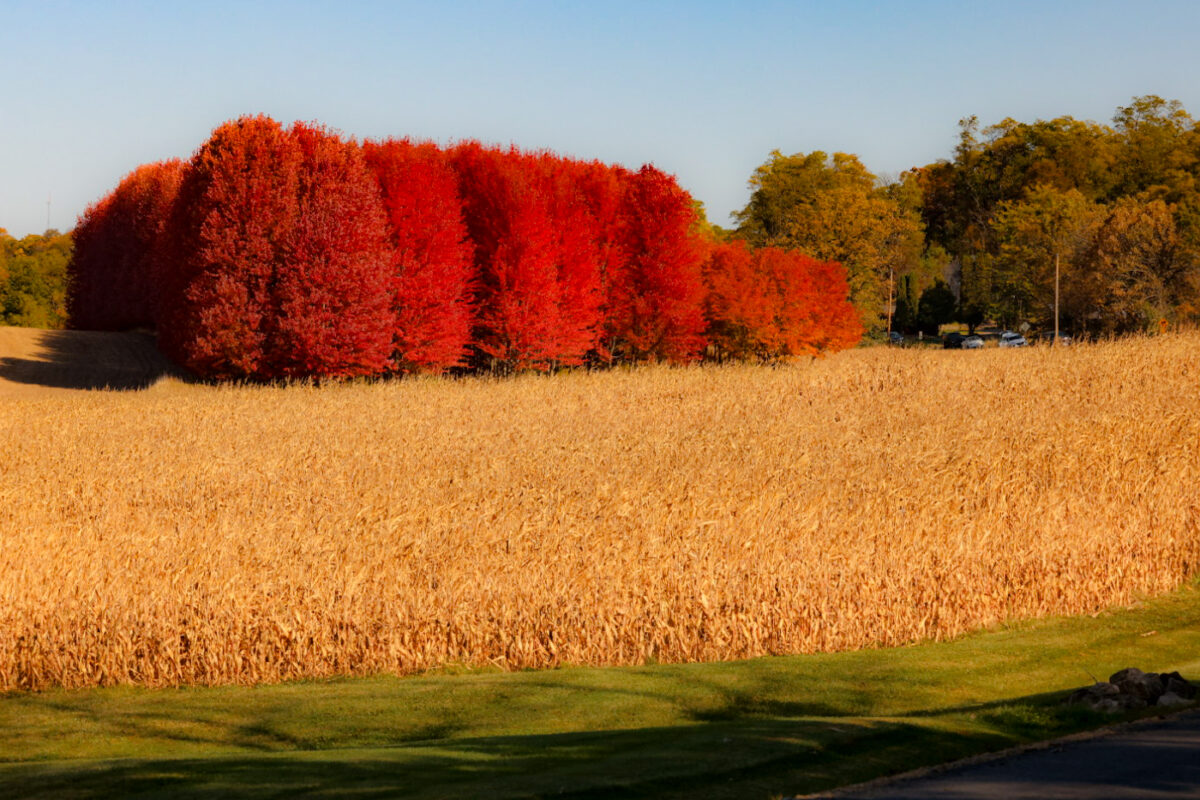
Arguably, the most anticipated characteristic of fall is the changing colors of the trees (unless you’re a football fan). As leaves slowly shift from their deep, summertime green to an array of fiery red, orange, and yellow colors, the landscape is filled with a new type of natural beauty.
When it’s Time to Turn a New Leaf
Shorter days coupled with longer, cooler nights warn trees that winter is approaching, prompting them to prepare for the dormant season. The timing of when they begin to do this is highly dependent on weather conditions.
The recipe that typically leads to ideal fall color vibrancy and duration is sunny, mild days and cool nights that are above freezing (32°F).
Too many cloudy fall days can delay the peak of colors and cause them to be muted.
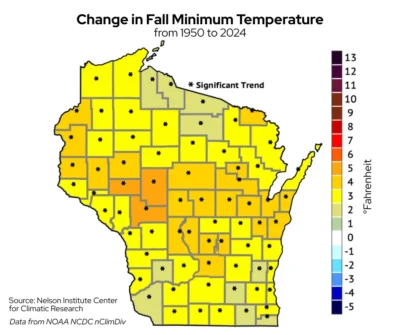
Warm nights during the fall can also mute or delay colors, as leaves stay on the trees longer. Wisconsin has experienced warming fall nights over the last 74 years, potentially causing shifts in the onset of fall colors (Figure 1).
Weather conditions from the spring and summer can also impact the timing of the color.
Periods of drought and prolonged periods of sunshine during the summer often cause plants to become stressed. In instances of severe drought, plants lack the energy to grow and sustain their leaves. Some will begin to enter winter dormancy early, leading to colors changing earlier and leaves falling faster than usual.
Excessive rainfall during the summer can lead to fungal diseases on leaves, causing trees to drop them before they have a chance to change color. Similarly, heavy rain or blustery winds in the late summer and early fall can knock leaves down prematurely.
Early frost or hard freezes can put an end to the vibrant colors and cause the early drop of leaves.
Pick a Color, Any Color
The leaves on many plants appear green because of chlorophyll, a substance that absorbs most colors of sunlight except for the green color. Chlorophyll helps plants create food and is the dominant pigment in most leaves.
As trees become less active in the fall, they produce less chlorophyll, causing the green color to fade and revealing the other hidden pigments in the leaves (Figure 2).
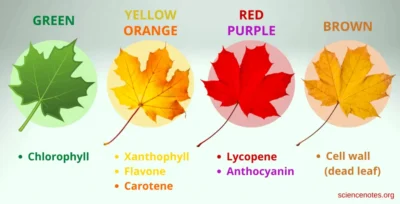
Pigments called carotenoids create yellow, orange, and brown colors, while anthocyanin pigments create shades of red, purple, and blue.
Carotenoids are present in leaf cells throughout the spring and summer, but are masked by the green of chlorophyll.
Anthocyanins are created in the fall as the tree begins to prepare for winter. Leaf veins begin to close, trapping carbohydrates in the leaves. Some trees will use those carbs to create the sugary anthocyanins that turn leaves a vibrant shade of red!
The Colors of Wisconsin
The variety and brilliance of Wisconsin’s fall colors are affected by the state’s two ecological regions, which have distinct vegetation types. These two regions are separated by a pronounced tension zone running diagonally from northwest Wisconsin near the Twin Cities toward the Milwaukee metro (Figure 3).
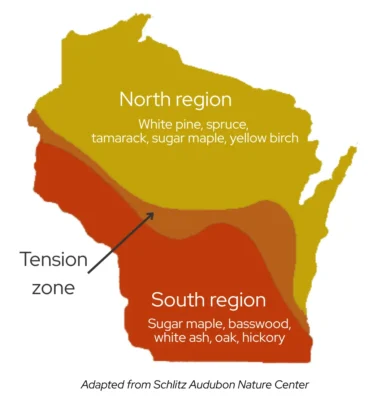
Due to typically cooler weather and a shorter growing season, the region to the north contains a northern mixed forest that includes conifers and deciduous trees. At peak color, this region sports vibrant yellows, golds, and reds from aspens, birches, and maples.
The southern region has a warmer climate and typically receives more rainfall during the summer. Longer growing seasons result in more open prairies and a southern broadleaf forest. In this region, the array of peak colors is dominated by the red, brown, and russet tones of oaks, as well as the golden bronze of hickory trees.
It’s in the Roots
The type of soil where the trees grow can also affect fall colors, as the soil moisture and nutrient levels influence a tree’s health and ability to produce vibrant leaf pigments.
Trees in Wisconsin’s Central Sands region may become more vulnerable to drought because of the sandy soils, resulting in dull colors.
Where loamy soils are found in Wisconsin’s hardwood forests, healthy trees often are more tolerant of dry summers and can produce more brilliant colors.
Reaching the Peak
The typical timing of peak fall color in a region depends on weather and climate factors.
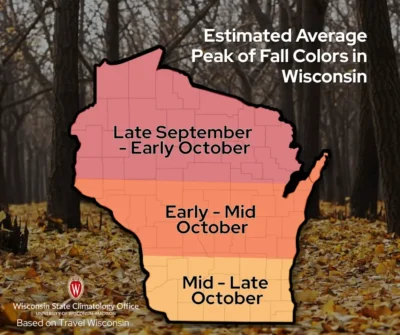
The peak season often begins in late September in northern Wisconsin and reaches the southern tier of counties during mid-to-late October (Figure 4).
Proximity to Lakes Michigan or Superior and altitude are also determining factors that impact local temperature patterns, consequently impacting color timing.
Individual tree species can have a mind of their own, though. Red maples tend to be among the earliest trees of the season to turn color, followed by sugar maples and hickories, while oaks tend to be the last to turn and lose their leaves in autumn.
Don’t Go Chasing Leaffalls
Knowing the typical timing of peak colors can be useful for general planning, but fluctuation of peak colors from year to year can necessitate a change in weekend plans or disappointing, less-than-brilliant scenery.
A fall foliage forecast map is updated through the fall season, predicting the southward progression of colors across the contiguous U.S. The map combines historical and forecast data, including temperatures and precipitation from NOAA, historical and predictive peak leaf color trends, and observer reports.
For local updates, the Wisconsin Department of Tourism maintains the Wisconsin Fall Color Report that provides weekly updates on color percentages and forecast peak dates at the county level.
Those chasing the fall scenery across state lines can find fall color report updates for the Michigan Upper Peninsula, Minnesota, and Iowa.
This is a product of the Wisconsin State Climatology Office. For questions and comments, please contact us by email (stclim@aos.wisc.edu) or phone (608-263-2374).